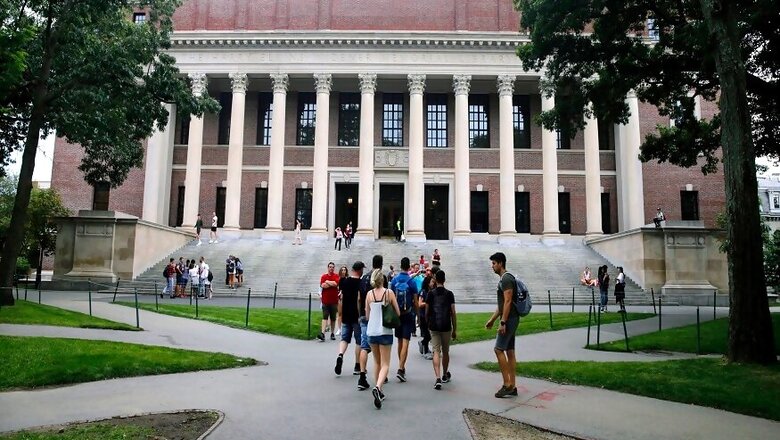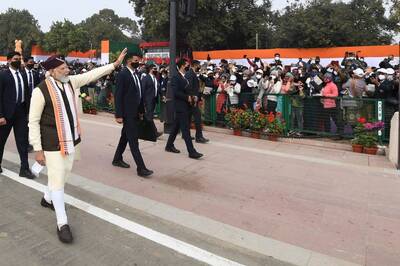
views
Were trade wars between the United States of America and China not enough to hurt US universities that the Donald Trump administration announced new Immigration and Customs Enforcement rules to keep international students away from pursuing higher education in the country, some experts and academicians are now asking.
A research paper titled 'Trade Liberalization and Chinese Students in US Higher Education' speaks on the consequences of trade wars and uncertainty over tariffs on student flow from China to the US for acquiring higher education.
“This paper takes a new approach as it is couched in the recent political and economic tensions between China and the US, that have led to recent trade wars and restrictions on flows of Chinese residents,” says Gaurav Khanna, assistant professor, School of Global Policy and Strategy University of California, San Diego. He is one of the co-authors of the report also written by scholars Kevin Shih, Ariel Weinberger, Mingzhi Xu and Miaojie Yu.
The researchers are of the view that in the last few years, with the trade wars, for the first time growth in students from China has stopped, hurting American universities. “The current guidelines barring the international students having online classes would have the same chilling effect on universities.”
Their estimates (without assessing the effect of ICE guidelines) suggest that the trade wars could cost US universities around $1.15 billion in tuition revenue.
The tariff uncertainty
Since 2017, the uncertainty over tariffs and trade wars resurfaced as US-China business relations soured. The policies of trade adopted by the USA showed by mid-2019 average tariffs on Chinese goods increased to nearly 20%.
An agreement in January 2020 reduced tariffs imposed on Chinese goods in exchange for concessions. Yet tariff uncertainty remains significant.
The researchers use their estimates on the effect of tariff uncertainty to make simple inferences on possible future changes in international student flows and services exports if Chinese industries face 20% higher tariffs.
Due to this, the estimates in the report show “enrolment should decline by 640 students in cities that have a population of 10 million”.
Given China’s urban population (the denominator in the study's outcome) this implies about 30,000 fewer students over 10 years, as per the report.
Assuming average tuition of $40,000 per year implies that, over 10 years, US institutions would lose $1.15 billion in tuition revenue, the research suggests. That is a “3% reduction in educational services exports and an 8% reduction in education exports to China, not including general equilibrium multiplier effects that may reverberate across local economies”, says the paper.
What goes around, comes around
The US has been accusing China of hurting its manufacturing sector. But what such accusations are lacking is having a complete picture.
Khanna explains that it missed an important point, which is “the money that flows out of the US when they buy goods from China, flows back as Chinese students pay for higher education in the US”.
Drawing very close links, the researchers show that cities in China that grew faster because of trade are the ones that sent more and more international students. “For instance, cities in China that were more dependent on textile production grew more quickly in the 2000s as textile tariffs fell,” Khanna said.
The residents of such cities grew richer. “And as they grew richer they sent more students to the US. In an indirect way, the money that drove the growth of the city came from abroad (as they exported textiles), and student migration partly cycled that money back abroad,” says Khanna.
This cycling back is unique in analysing the effect of trade wars on student flows from China. The researchers do the entire exercise in reverse and ask after establishing the above cycle: “what would happen if we had trade wars and money was not flowing to China?” The answer is “then that would really hurt US universities”, explains Khanna.
As a result, in the last few years with the trade wars, “for the first time growth in students from China has stopped, hurting universities. The current guidelines would have the same chilling effect on universities,” he says.
Trade wars, ICE and elections
In the paper once published, one can see that the flow of students from China is helping the very places in the US that were on an economic decline.
“These are small mid-western towns, in places like Indiana and Michigan, where other forms of employment have been falling. Such restrictions will hurt them, in a year that the midwest is an important part of the election,” says Khanna.
The paper, expected to be published in Washington DC-based think tank Center for Global Development, highlights a lesser-known consequence of China’s growth and integration into the world economy in relation to the United States: the rise of services trade.
Focusing on China’s accession to the World Trade Organization, the researchers show that Chinese cities more exposed to this trade liberalisation episode sent more students to US universities.




















Comments
0 comment